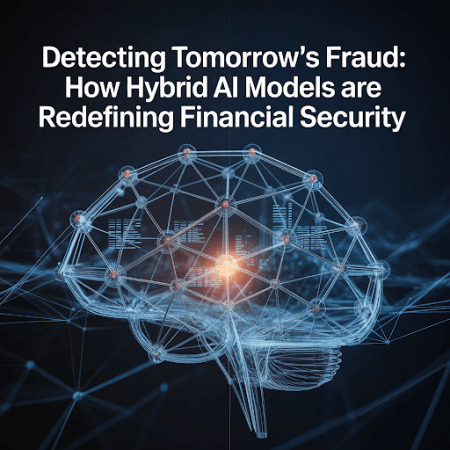
Breaking the Cycle of Old Solutions
For decades, financial institutions have relied on static rules and basic decision trees to detect fraud. While these conventional systems have been the backbone of fraud prevention, they are now struggling to keep pace with today's dynamic threat landscape. Recent studies highlight that these traditional tools are burdened with high false positive rates, sometimes reaching up to 22.7% during peak transaction periods, and fail to identify complex fraud schemes with the needed agility. As fraudsters develop ever more sophisticated techniques, the industry's losses have surged, prompting an urgent need for adaptive and intelligent detection systems.
The Rise of Hybrid AI: A New Era in Fraud Detection
A new era in fraud detection is driven by a hybrid, multi-layered AI system that processes over 12,500 transactions per second with sub-87 ms latency. By fusing graph neural networks, temporal deep learning, autoencoders, and adaptive boosting, it achieves 93.8% accuracy, reduces false positives by 42.6%, and improves detection of complex attacks by over 11%.
Innovations That Set the Standard
The framework introduces a suite of groundbreaking innovations:
- FraudNet: A domain-specific graph neural network tailored to uncover hidden fraud rings by mapping the intricate web of transactions. FraudNet has demonstrated a remarkable 91.8% accuracy in detecting synthetic identity fraud networks, far surpassing previous technologies.
- Time-Aware Autoencoders: By blending temporal attention mechanisms into unsupervised learning, these autoencoders excel at identifying sudden behavioral shifts—catching account takeovers and "burst" transactions often missed by standard models.
- Real-Time Reinforcement Learning: The system continuously adapts to new threats by dynamically adjusting detection thresholds based on real transaction outcomes, reducing adaptation times to emerging fraud patterns by over 74% compared to industry averages.
- Multi-View Fusion: This integrative analysis enables the system to draw from multiple data perspectives simultaneously, yielding a more robust and holistic fraud risk assessment than any single-view solution.
Performance and Impact Beyond the Lab
Real-world validation showed that the hybrid AI model reduced fraud-related losses by almost 48% within six months in large financial networks, saving tens of millions of dollars. It also increased approval rates for legitimate transactions, halved fraud resolution time, reduced false alerts, lowered operational costs, and boosted customer trust, as seen in fewer complaints and higher Net Promoter Scores.
Tackling the Biggest Technical Hurdles
Overcoming major technical hurdles required innovative approaches. To address the rarity of fraudulent transactions, advanced synthetic data generation and oversampling were used. Scalability challenges were solved through distributed AI processing and model quantization, cutting processing times by 71%. Adversarial attacks were countered with adversarial training and continuous update pipelines, reducing vulnerability to emerging fraud tactics.
Ethical Safeguards and a Look Ahead
Ethics and governance are integral to the system, focusing on minimizing bias, enhancing transparency with explainable AI, and ensuring privacy through differential privacy and federated learning. These safeguards reduce demographic disparities, clarify fraud decisions, and protect sensitive data. Looking ahead, advances like integrating AI into cryptocurrency monitoring, enabling cross-institution collaboration, and using large language models for fraud detection promise to further strengthen fraud detection and financial system security.
In conclusion, by uniting graph-based analysis, deep learning, and adaptive AI, Sravanthi Akavaram's research establishes a new gold standard for financial fraud detection one that's fast, resilient, and ethical. As the arms race with cybercriminals continues, these innovations are poised to secure the future of digital finance for institutions and customers alike.

















